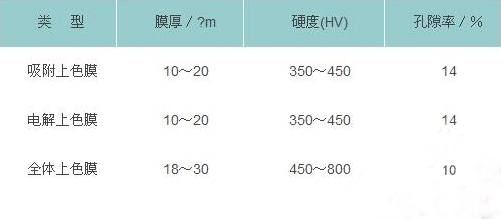(1) Methods of electrolytic coloring
Electrolytic coloring can be divided into two-step coloring and two-step coloring according to the characteristics of its color development. In the meantime, the color of one step is also called the whole color or natural hair color, that is, the method of anodizing aluminum and aluminum alloy parts in organic acid to obtain colored oxide film, and also the specific aluminum alloy is colored in general anodizing. There are three conditions in this method: one is anodizing in organic acid electrolytic solution, one is alloy electrolytic coloring method, also known as natural coloring method, and the other is aluminum alloy organic acid solution cathode electrolysis Coloring. Regardless of the coloring, the aluminum alloy is electrolytically developed in various electrolyte solutions at one time and is in one step. The one-step electrolysis coloring skill is narrow in scale, the operating conditions are strict and disordered, and the color of the film layer is greatly affected by the type of material, electrolyte composition and operation skill, and thus it is subject to certain restrictions.
The two-step coloring method is a two-step treatment of the anodizing and coloring process of aluminum. The first step is to oxidize the aluminum and aluminum alloy parts into a film by a general anodizing method. Then coloring, the method of coloring is divided into two types: adsorption coloring method and electrolytic coloring method.
Therefore, the electrolytic coloring treatment of aluminum and aluminum alloys is divided into three major categories, namely, adsorption coloring method, electrolytic coloring method and natural coloring method.
(2) Comparison of several electrolytic coloring methods
Although there are several kinds of electrolytic and coloring methods for aluminum and aluminum alloys, each has its own characteristics. However, as long as it compares the functions of the film, the skills and equipment of the coloring, and the cost of production, it can be based on the actual production situation and The demand for goods picks the most appropriate one.
1. The function of electrolytic film of aluminum and aluminum alloy
From the color contrast, the color of the adsorption color method is more complete, and the color of the other two methods is contrasted, but the color type and the series are less contrasted. As a large-scale construction of the profile, the firmness and stability of the color is an important factor, and the solidity and stability of the adsorption color are poor, and the contrast of electrolytic coloring is good. Natural hair color (all colors) is the best. The good reason is strongly related to the principle of coloring and the way the “pigments†are stored. As shown in Figure 4-1, it can be seen from Figure 4-1 that the pigmented pigment is adsorbed on the surface of the membrane pore, so it is simply lost, or is discolored or discolored by the effect of strong light and strong heat. The color pigment is deposited at the bottom of the film hole, and the color and firmness of the color are related to the amount of pigment deposited and the skill of sealing. The pigments of the whole coloring method are combined with the three coloring principles to suggest that the film layer is combined, so it is the strongest and stable.
The other functional comparison of the membrane is shown in Table 4-1. 
Comparison of various dyeing of aluminum and aluminum alloy
It can also be seen from Table 4-1 that the film density and corrosion resistance of the adsorption coloring method can be both, but the abrasion resistance is poor, and it is only suitable for indoor decoration profiles and decoration of daily necessities or skill art. .
The color film of the electrolytic coloring method is relatively fine, and the functions of abrasion resistance, corrosion resistance, light resistance and heat resistance are excellent, especially the corrosion of the mortar cement, so it is most suitable for the construction of door frames, windows and other profiles. The natural coloring film is the best, the film layer is very fine, and the abrasion resistance, corrosion resistance, light resistance and heat resistance are also excellent, but the function of the mortar resistant cement is not as good as that of the electrolytic color film. 2. Skills and equipment for three coloring methods
The technique of adsorption coloring is the most simple, the process is small, the equipment is simple, easy to make, and the investment is small. The skills of electrolytic coloring are relatively cluttered. It is necessary to have two sets of power supply equipment and oxidative coloring equipment. The construction is not complicated, but the investment is relatively high, and the one-time investment is large. The natural hair coloring rule is between the two, the process is not too much, and the equipment investment is not too large.
3. Production costs
Thinking from the cost of production, the lowest cost of the adsorption method, the electrolytic coloring method is higher, and the natural coloring method is the highest, mainly because the electrolyte is more expensive organic acids and other reagents. In addition, the color electrolysis is high, and the electric consumption is relatively large.
It can be seen from the above that the three electrolytic coloring skills have their own characteristics, advantages and disadvantages, so they should be selected according to the actual situation and needs. In general, the adsorption coloring method is mostly used in the interior decoration and the production of common and finished products. Electrolytic coloring is often used to construct profiles. The natural color of the color film is superior, but the cost is high, and can only be used in occasions with high demand. If you can reduce the cost, especially the power consumption, there will be a broader perspective.
popular searches:  Aluminum art accessories    Luxury aluminum art villa door    Aluminum art stair railing   Aluminum art security window   Aluminum art fence    Aluminum art fence   Aluminum canopy
Satin Chiffon Fabric,Satin Chiffon,Silk Satin Chiffon,Silk Satin Chiffon For Sale
Suzhou Wangsheng Textile Co.Ltd , https://www.jzwstex.com